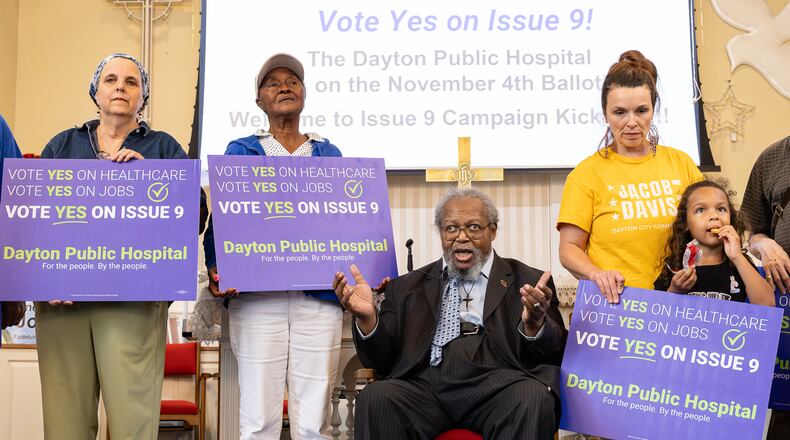Opponents say there is no chance that such a small amount of money could advance an incredibly expensive and complicated hospital project.
Dayton voters will have to decide which side they believe and whether the proposal is worth paying higher property taxes.
Credit: Bryant Billing
Credit: Bryant Billing
Successful petition drive
The Clergy Community Coalition earlier this year obtained enough signatures from registered Dayton voters to put a tax levy measure in support of a new public hospital on the Nov. 4 ballot, called Issue 9.
The coalition was formed by a group of faith leaders and activists after Premier Health decided to close Good Samaritan Hospital in northwest Dayton in 2018. The coalition unsuccessfully tried to stop Good Sam from closing and being demolished.
Premier Health officials said maintaining the aging hospital was getting very expensive and oftentimes about half of its hospital beds were empty. The health care system also said many of Good Sam’s services were available about five miles away at Miami Valley Hospital.
Following a couple of failed attempts, the Clergy Community Coalition over this past summer got enough Dayton electors to sign a petition for a ballot initiative in support of a public hospital.
The proposed 1-mill levy is projected to raise about $2 million annually for 10 years, costing the traditional owner of $100,000 home about $35 per year.
Credit: Bryant Billing
Credit: Bryant Billing
The ballot initiative says the public hospital must be constructed in West Dayton and must have a level 2 trauma center, an intensive care unit, pediatric emergency services, mental health programs, a diagnostic lab, an imaging center, a birthing center, an outpatient obstetrics clinic and other services.
Bishop Richard Cox, president of the Clergy Community Coalition, said Good Sam served about 35,000 people in northwest Dayton and the facility’s closure created a medical desert that impacts many vulnerable community members, including the elderly and individuals with chronic health conditions. He said West Dayton no longer has critical, life saving emergency services.
Cox has said passing the Issue 9 levy will send a strong message that Dayton residents want a new public hospital and the vote and new levy dollars hopefully will help attract other partners to the project.
$21B price estimate
In August 2024, the Dayton City Commission heard from Eric Dillinger, global head of management consulting for Woolpert, an architecture, engineering and geospatial firm that is headquartered in Beavercreek.
Woolpert produced a report at the request of city officials that estimated that a new 300-bed hospital could cost more than $21 billion to own, operate, staff and maintain over a period of about 40 years (or about $525 million annually).
Dillinger said the facility costs alone for this medium-sized hospital could be about $1.5 billion over 40 years, or about $39 million annually.
“This is one of the most complex types of facilities the U.S. operates,” he said, adding that his estimates were fairly conservative and actual costs probably would be higher.
Dayton Deputy Director LaShea Lofton at a city commission meeting earlier this year said Woolpert’s study found that construction costs for a public hospital would be about $450 million, not including property acquisition or site development expenses.
She said the Woolpert study’s cost estimates were for a 750,000-square-foot facility, and that facility size was selected based on the service parameters contained in the ballot language.
“With all of the information contained in that study, we concluded that building a new hospital with public funds and managing it is both inefficient and ineffective due to the high costs, the ongoing maintenance requirements and the operational challenges facing public hospitals today,” Lofton said.
Questioning the study
Some Issue 9 supporters say the cost estimates in Woolpert’s report seem wildly inflated by design, to make a public hospital project appear to be financially doomed to fail.
Nancy Kiehl, community outreach coordinator of the coalition, said the city arbitrarily selected to study a 300-bed facility, when the public hospital in actuality might start off with 20 beds or maybe 40 beds down the line, if the facility is built out in phases.
Kiehl said levy funds are meant to serve as seed funding.
“This is a way for the people of the city of Dayton to be vested in a public hospital, and they would be part of the process of creating this public hospital,” she said. “This is foundational — the first layer of the capital stack, so to speak, for funding, a seed."
Kiehl said the city pulled together nearly a century ago to create Good Sam, and the community has an opportunity now to do something very similar. In 1928, the Dayton community teamed up with the Sisters of Charity in Cincinnati to raise $1 million to help pay to build Good Sam.
If the levy passes, hospital supporters will step up efforts to reach out and collaborate with county, state, federal and private organizations to try to secure funding for the project, Kiehl said.
Kiehl said smaller hospitals, like satellite facilities, have been built for between $15 million to $20 million. She said initial research suggests that a public hospital project like what’s being considered potentially could cost around $60 million to construct.
She said an expert in hospital feasibility studies who looked at Woolpert’s report found the numbers laughable. She said projecting costs out 40 years is ridiculous and unhelpful.
Kiehl said levy funding initially would be used to hire an architect to come up with a design and plan for a new hospital, after getting input from community members.
Price of a new hospital
Hospital projects can widely vary in price.
A “neighborhood hospital” opened in St. Clairsville this year with 10 emergency room beds and six inpatient beds; it had a projected building cost of $12 million. A new 60-bed hospital and medical office complex in Mason that opened last year had a budget of $156 million. A 220,000-square-foot hospital in Pickerington opened in 2023 with a $140 million investment that created 60 beds.
Definitive Healthcare estimates that average operating expenses for hospitals with 25 or fewer beds is about $40 million annually, while operating costs for facilities with 250 or more beds is almost $1 billion.
Dayton City Commissioner Matt Joseph told his news outlet that Issue 9 backers have no real plan to make the public hospital project a reality if the levy were to pass.
He said it’s unfair and irresponsible to give residents false hope that they will get a new full-service hospital on the west side, when $2 million in annual funding is a very tiny fraction of the money that would be needed to make this project work.
Joseph said the city does not have the expertise or the resources to own and operate a public hospital.
Building and maintaining a hospital requires significant funding investments in the early stage along with ongoing investments in capital improvement projects to ensure the facility remains up-to-date to meet community need, said Sarah Hackenbracht, president and CEO of the Greater Dayton Area Hospital Association.
“Budgeting to build and operate a hospital is complex and further challenged by rising inflation that continues to drive up construction costs,” she said. “Hospitals across the country are navigating workforce shortages, including more than 1,250 positions that are open in the Dayton region today.”
About the Author



